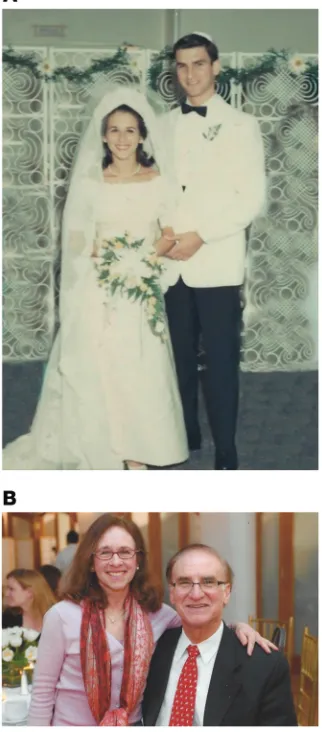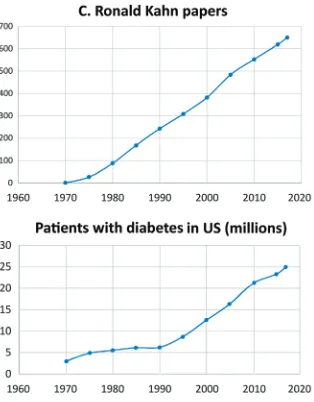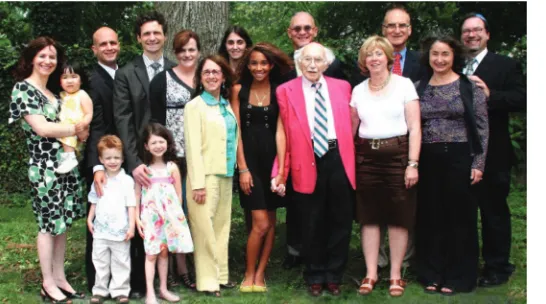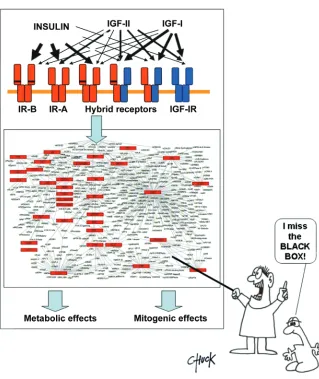George M. Kober Medal Presentation
C. Ronald Kahn: The Louisville Slugger of
metabolic science
Jeffrey S. Flier
J Clin Invest.
2019;129(12):5066-5070. https://doi.org/10.1172/JCI133156.
Good afternoon. It’s an extraordinary honor and pleasure for me to be asked by the AAP to
present the 2019 Kober Medal to Professor C. Ronald Kahn, my close friend and colleague
for the past 45 years. I can think of no person more deserving of this prestigious award. The
early days As some of you know, Ron grew up in Louisville, Kentucky, so my celebratory
comments will have a Kentucky theme. Just as the Kentucky Derby begins with a call to the
Derby, we might begin this event with a “Call to the Kober, 2019” (Supplemental Video 1;
supplemental material available online with this article;
https://doi.org/10.1172/JCI133156DS1). At his core, those who know him well see Ron as
basically “the boy from Louisville.” This is a city known for the Louisville Slugger baseball
bat and the Kentucky Derby, but in the realm of medical science, it is also known as the
birthplace of C. Ronald Kahn. Ron’s “Old Kentucky Home” was a house on Meadow Road.
If it hasn’t yet, this house should someday be decorated with a prominent brass plaque to
record this history. The core Kahn family included his mom and dad, Reva and Dave, and
his older brother Arnie (Figure 1). They were a source of great love and support during his
childhood. Speaking of love, here […]
AAP Kober Medal Presentation
Find the latest version:
2019 Association of American Physicians George M. Kober Medal Presentation
C. Ronald Kahn: The Louisville Slugger
of metabolic science
Jeffrey S. Flier
G
ood afternoon. It’s an extraordinary honor and pleasure for me to be asked by the AAP to present the 2019 Kober Med-al to Professor C. RonMed-ald Kahn, my close friend and colleague for the past 45 years. I can think of no person more deserving of this prestigious award.The early days
As some of you know, Ron grew up in Lou-isville, Kentucky, so my celebratory com-ments will have a Kentucky theme. Just as the Kentucky Derby begins with a call to the Derby, we might begin this event with a “Call to the Kober, 2019” (Supplemen-tal Video 1; supplemen(Supplemen-tal material avail-able online with this article; https://doi. org/10.1172/JCI133156DS1).
At his core, those who know him well see Ron as basically “the boy from ville.” This is a city known for the Louis-ville Slugger baseball bat and the Kentucky Derby, but in the realm of medical science, it is also known as the birthplace of C. Ron-ald Kahn. Ron’s “Old Kentucky Home”
was a house on Meadow Road. If it hasn’t yet, this house should someday be decorat-ed with a prominent brass plaque to record this history.
The core Kahn family included his mom and dad, Reva and Dave, and his older brother Arnie (Figure 1). They were a source of great love and support during his childhood. Speaking of love, here is a wed-ding picture of Ron and Suzi from 1966 (Figure 2A). Fifty-three years later they are still happily together (Figure 2B).
After graduating with highest hon-ors from the University of Louisville, Ron set his sights on a medical career, and entered the University of Louisville Med-ical School. Ron performed at a high level in med school, and then matched at Barnes Hospital and Washington University in St. Louis for his medical residency. Suzi took this picture as Ron walked into the Hospital on the first day of his internship (Figure 3).
The NIH days
Two years later, Ron set out for Bethesda to begin a glorious 11-year career at the NIH, working in the Clinical Center, Building 10. Ron set up home in the Diabetes Branch of the NIDDK as a fellow of Jesse Roth, the Branch Chief, who became my men-tor three years later. When Ron arrived in 1970, Jesse had been working for several years to begin to define, characterize, and understand the biology and disease rele-vance of membrane receptors for peptide hormones. While these started with studies of ACTH, insulin receptors soon became the most critical model employed in the lab. Jesse and the people working with him during that period were really responsible for establishing this critical field, the pre-cursor to what is now referred to as the field
of signal transduction. Before this work, it was still debated whether insulin action began at the cell surface or began inside the cell, and if it began at the surface, what was the “second messenger” that mediated its action. Although they made fundamental discoveries, and established that the first step of insulin action was binding to a cell surface receptor, in retrospect what they actually understood then about the insu-lin receptor and insuinsu-lin action was very
Copyright: © 2019, American Society for Clinical Investigation.
Reference information: J Clin Invest. 2019;129(12):5066–5070. https://doi.org/10.1172/JCI133156.
[image:2.585.384.545.186.552.2]This article is adapted from a presentation at the AAP/ASCI/APSA Joint Meeting, April 6, 2019, in Chicago, Illinois, USA.
Figure 1. The core Kahn family in front of their Louisville home. Left to right: Ron, Reva, Dave, and Arnie Kahn.
[image:2.585.36.195.500.638.2]Part 2 of Ron’s greatest hits continued in Boston. In 1991, he and associates iden-tified and defined the first insulin recep-tor substrate, IRS-1 (9), and in 1994 this allowed them to expand and clarify under-standing of downstream signaling path-ways (10). Beginning in 1999, the Kahn lab used gene targeting to knock out insulin receptors in numerous tissues, including
β cells (11), neurons (12), and adipocytes Nobel Laureates, of which Lefkowitz is one
(Supplemental Video 3).
Jesse Roth was not from Kentucky, or the Bronx, but from Brooklyn. I asked him to say a few words (Supplemental Video 4).
To prepare for this talk, I actually did substantial research, aiming to uncov-er details on when and how Ron gained his interest in diabetes research. I went into the archives of the Banting and Best Institute in Toronto, where Banting and Best (and their experimental dog Margie) accomplished the impossible in 1921 — they discovered insulin. What I found, at the bottom of a box of old pictures, will astound you, as it did me (Figure 5). Some-how, Ron was actually there! Whether he was subsequently deleted from the picture and the story because he was not Cana-dian, or because he wore plaid pants like those seen here, will require more years of historical analysis.
Scientific contributions
To briefly review Ron’s scientific contri-butions, I will run through some of Ron’s greatest hits. Part one involves his con-tributions during the NIH years. In 1973, Ron and colleagues established that insu-lin receptor expression was altered in the severely insulin-resistant ob/ob mice (1). Although discovery that the cause of this obesity syndrome was a mutation in the gene for the fat cell hormone leptin would not be discovered until 1994 (2), this work established that receptor binding activity could be altered in an important disease model, increasing interest in receptor biology. In 1974, Ron published a paper characterizing in great detail the kinetics and specificity of liver membrane insulin receptors (3). In 1975 (4) and 1976 (5), Ron and colleagues identified two human syn-dromes of severe insulin resistance, and showed that these were in fact disorders of insulin receptors, one caused by antibod-ies against the receptor (work with me) (4, 5) and the other most likely due to genetic defects in the receptor. In 1978, the anti-re-ceptor antibodies were shown to be capable of being agonists of insulin action in adipo-cytes, through receptor crosslinking (6). In 1982, Ron and colleagues showed for the first time that activating the insulin receptor would stimulate its own phosphorylation, a major breakthrough (7). In 1983 this was shown to be tyrosine phosphorylation (8). limited. This is captured in an immortal
cartoon drawn in 1979 by the scientist and cartoonist Pierre DeMeyts (Figure 4) show-ing that insulin binds to its receptor, then something happens, but what happened was really a black box! A long way since the black box concept!
[image:3.585.42.201.55.225.2]Phil Gorden, one of Ron’s early men-tors, and a close collaborator of Jesse Roth, was a product of an even deeper place in the South — Mississippi (Supplemental Video 2)! The clinical associate who imme-diately preceded Ron in the lab was Bob Lefkowitz. Bob, or Lefko as he was called, was not from Kentucky or Mississippi, but from the Bronx. Bob attended the Bronx High School of Science, as I did a few years later. Bronx Science was and remains an amazing school that graduated many
[image:3.585.390.550.59.280.2]Figure 3. Ron entering Barnes Hospital on the first day of his internship.
[image:3.585.40.199.290.444.2]Figure 4. Cartoon by Pierre DeMeyts from 1979, illustrating knowledge at the time on insulin action.
Figure 5. Banting, Kahn, and Best in 1921, cele-brating the earliest phase of insulin discovery.
[image:3.585.393.550.486.687.2]humor, but he replied — I don’t do humor (Supplemental Video 6).
Ron has assembled amazing lab groups over the years, a remarkable number of whom became leaders in the field of dia-betes research, in the US and around the world. One of his legacies was outstand-ing mentorship of women scientists, one of whom was my wife, Terry Maratos-Flier (Supplemental Video 7).
Ron has won every award in the field of diabetes, and many outside the field. When he won the Banting award in 1993, he stood between Jesse Roth, who won it before he did, and me, who would go on to win this award (Figure 8).
Turning back to his personal life, you can remove Ron from Louisville, but you can’t remove Louisville from Ron. Here’s the extended Kahn family in 2009, at Ron’s father Dave’s 100th birthday cele-clear positive correlation between Ron’s
scientific productivity and the prevalence of diabetes, which his research, as stated in numerous grant proposals, was aiming to reduce (Figure 6B). Fortunately, cor-relation doesn’t imply causation! In fact, my research reveals for the first time that diabetes prevalence would have been far greater if not for Ron’s scientific output, a point that Ron stresses in all grant propos-als (Figure 6C).
Boston, Joslin, and Harvard
[image:4.585.302.544.57.228.2]After 11 amazing years in Bethesda, includ-ing 4 when we closely interacted, Ron left the NIH, and was presented with his sci-entific symbol, a Louisville Slugger bat (Figure 7). The Harvard/Joslin Era began in 1981. I asked Dr. Eugene Braunwald, who recruited Ron to Boston, to offer a few comments. I asked him to inject some (13), producing many new insights into the
complex biology of insulin. Not resting on his laurels, Ron has extended his research into new areas. Most recently, his work on the microbiome (14) and discovery of virally encoded insulin-like peptides (15) pushes our understanding of insulin action and the Kahn discovery envelope even further.
Now, sometimes Ron’s productivity creates problems for other scientists in the field. Mike Czech and his fellows explain this in this video (Supplemental Video 5).
[image:4.585.37.285.58.227.2]Another way to capture Ron’s pro-ductivity is to graph his number of pub-lications as a function of time. This plot reveals a nearly perfectly linear produc-tivity from 1975 onwards (Figure 6A). We might then ask what effect this research has had on the prevalence of diabetes. Unfortunately, after an initial lag, there is a
Figure 7. Jesse Roth marks Ron’s departure from the NIH for Boston by
presenting a Louisville Slugger bat. Figure 8. Celebrating the presentation of the Banting Award from the American Diabetes Association to Ron Kahn in 1993. Left to right: Susan Roth, Suzi Kahn, Jesse Roth, Ron Kahn, Jeff Flier, Terry Maratos-Flier.
[image:4.585.37.310.568.720.2] [image:4.585.242.529.568.723.2]bration (Figure 9). His daughter Stacy and son Jeff, doctor and lawyer, are the apple of their dad’s eye (Figure 10). And Ron with his four wonderful grandkids (Figure 11)!
With all of his success, Ron is still taking risks in both his research and his recreation (Figure 12). So much has been learned about insulin action since Pierre DeMeyts drew his famous cartoon in 1979 (Figure 4). Today, insulin signaling is no longer a black box. Instead, everything about insulin action is perfectly explained. To illustrate, I commissioned a new car-toon on the current state of insulin action by Pierre DeMeyts (Figure 13). Those of us there from the beginning confess that on some level, we do miss the simplici-ty of the black box. While a lot has been learned, not everything about insulin action is yet explained.
[image:5.585.350.548.57.256.2]So, in the end, Ron Kahn is a man for the ages, and a true scientific Louisville slugger. His impact on the Joslin Diabe-tes Center, Harvard Medical School, and the international scientific community will last far into the future. In the end, I can say this: Through research conduct-ed over the past 48 years at the NIH, Jos-lin, and Harvard, no one has contributed more than Ron Kahn to our understand-ing of insulin, insulin signal transduction, insulin’s complex multiorgan physiologic actions, and insulin’s role in human dis-ease. He is most deserving of the 2019 Kober Medal, and it’s a great pleasure for me to present him to you today.
[image:5.585.42.325.57.260.2]Figure 13. Cartoon by Pierre DeMeyts, illustrating how far we have come since the “black box” in explaining insulin action pathways.
[image:5.585.45.364.313.692.2]11. Kulkarni RN, Brüning JC, Winnay JN, Postic C, Magnuson MA, Kahn CR. Tissue-specific knock-out of the insulin receptor in pancreatic beta cells creates an insulin secretory defect similar to that in type 2 diabetes. Cell. 1999;96(3):329–339. 12. Brüning JC, et al. Role of brain insulin receptor
in control of body weight and reproduction.
Sci-ence. 2000;289(5487):2122–2125.
13. Blüher M, Kahn BB, Kahn CR. Extended longevi-ty in mice lacking the insulin receptor in adipose tissue. Science. 2003;299(5606):572–574. 14. Ussar S, et al. Interactions between gut
microbi-ota, host genetics and diet modulate the predis-position to obesity and metabolic syndrome. Cell
Metab. 2015;22(3):516–530.
15. Altindis E, et al. Viral insulin-like peptides acti-vate human insulin and IGF-1 receptor signaling: A paradigm shift for host-microbe interactions.
Proc Natl Acad Sci U S A. 2018;115(10):2461–2466.
1976;294(14):739–745.
6. Kahn CR, Baird KL, Jarrett DB, Flier JS. Direct demonstration that receptor crosslinking or aggregation is important in insulin action. Proc
Natl Acad Sci U S A. 1978;75(9):4209–4213.
7. Kasuga M, Karlsson FA, Kahn CR. Insulin stim-ulates the phosphorylation of the 95,000-dal-ton subunit of its own receptor. Science. 1982;215(4529):185–187.
8. Kasuga M, Zick Y, Blithe DL, Crettaz M, Kahn CR. Insulin stimulates tyrosine phosphorylation of the insulin receptor in a cell-free system.
Nature. 1982;298(5875):667–669.
9. Sun XJ, et al. Structure of the insulin receptor substrate IRS-1 defines a unique signal transduc-tion protein. Nature. 1991;352(6330):73–77. 10. Araki E, et al. Alternative pathway of insulin
signalling in mice with targeted disruption of the IRS-1 gene. Nature. 1994;372(6502):186–190. 1. Kahn CR, Neville DM, Roth J. Insulin-receptor
interaction in the obese-hyperglycemic mouse. A model of insulin resistance. J Biol Chem. 1973;248(1):244–250.
2. Zhang Y, Proenca R, Maffei M, Barone M, Leo-pold L, Friedman JM. Positional cloning of the mouse obese gene and its human homologue.
Nature. 1994;372(6505):425–432.
3. Kahn CR, Freychet P, Roth J, Neville DM. Quan-titative aspects of the insulin-receptor interac-tion in liver plasma membranes. J Biol Chem. 1974;249(7):2249–2257.
4. Flier JS, Kahn CR, Roth J, Bar RS. Antibodies that impair insulin receptor binding in an unusual diabetic syndrome with severe insulin resis-tance. Science. 1975;190(4209):63–65. 5. Kahn CR, et al. The syndromes of insulin



